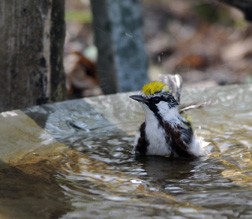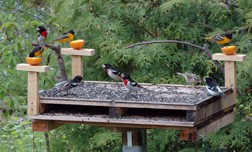Providing Food and Water for Birds Year-round
- Share
- Tweet
- Pin
- Share

A male Chestnut-sided Warbler appears very content bathing in the recycled satellite dish.
Charlotte and I have been feeding and watering birds virtually every day of our married lives for the past 41 years, and I did so for six years before that. We are occasionally criticized with statements such as, “Feeding birds decreases their ability to find natural food, which is better for them in the first place.” Another argument is: “Artificial feeding of birds messes up their migratory patterns, and they remain here longer than they should.”
Field studies by Dr. Stanley Temple, Professor Emeritus of Conservation in the Dept. of Forest and Wildlife Ecology, UW – Madison, have shown that birds feeding at backyard feeders obtain only roughly 25 percent of their daily food supply from people’s handouts and the remaining 75 percent from nature. Surely there are times during highly adverse weather, such as long-lasting snowstorms, when our feeding is of great value to the survival of some birds. Periods of bad drought also bring many birds to our handout of water.
We look at our daily contributions to the birds and other wild creatures as providing us great enjoyment in being able to see and study them so intimately. Eventually one gets to know a few of them “personally,” and what great fun that is. Daily notes are recorded of various species in our front yard feeding area – seasonal arrival and departure dates, dates when some of the young are first seen along with the adults at the feeders, and other unusual observations – are filed by month and year for future comparisons and study.

Rose-breasted Grosbeaks and Baltimore Orioles are lured to the well-stocked platform feeders.
One bird species of which we’ve become very fond is the Hermit Thrush. A pair has nested in our lower woods north of the house for the past seven summers. Recently, Charlotte, for the second consecutive day, observed one at our large birdbath on the ground at about 8:30 pm. They come like clockwork each evening only to bathe and to drink, never to feed. Often both of the pair will be in the bath together. A good place to hear their exquisite and lovely song, and occasionally to see the birds, is at Whitefish Dunes State Park.
Our offerings to the birds go through a few seasonal changes. Five foods we feed year-round include black oil sunflower seeds, nyjer seeds, safflower seeds, suet blocks and yellow millet. Sunflower seeds are placed on open, raised, squirrel-proof platforms. The millet and safflower seeds are scattered on the ground where they are relished by many of the small birds as well as Cardinals, Mourning Doves and Chipmunks. Suet blocks are placed in both plastic-covered metal cage-type feeders and in one of my homemade feeders, while nyjer seeds are put into fine-mesh hanging bags.
Recently nothing had happened. They’re accustomed to feeding while hanging upside down; however, the Blue Jays have to struggle to get even the tiniest amount of suet, so, for the time being, they are not gorging at the suet.

Here are our water offerings before we began using the satellite dish.
Even the Baltimore Orioles, in light of the cold weather and general shortage of many insects, have been eating some many Blue Jays have been emptying the suet block feeders much faster than I care for, so it was easy to design the feeders to hang horizontally rather than vertically. The Pileated, Red-bellied, Hairy and Downy Woodpeckers, Black-capped Chickadees and the White-breasted Nuthatches took to the horizontal feeders as though suet, and their wonderful dexterity hasn’t prevented them from easily dining at the newly positioned feeder. The oranges we’ve put out ever since the orioles and Scarlet Tanagers returned have been, as in past years, highly attractive to these flashy creatures. Occasionally we put small amounts of grape jelly on top of the orange halves fastened to two corners of one of the raised platform feeders. We’re taking the word of the experts who claim that too much grape jelly is not suitable steady fare for these birds – a little is okay.
Last year our satellite-signal receiving “dish” had to be replaced and it was left for us to dispose of – as a perfect water bath for the birds. After a few small bolt holes were plugged up, the dish was painted a dull color and placed upon the ground on a small tripod of stones to keep the bath level. Songbirds of all sizes took to it immediately. The slope is very gentle allowing the birds to inch their way unhesitatingly into the water as deeply as they wish. It was not uncommon, for example, during the warbler migration, to see as many as a dozen Nashville Warblers bathing and splashing in the 26-inch diameter dish at the same time.
Placed on top of a small 2½-foot-high wooden platform directly behind the dish I have a recycled plastic 3- to- 4-gallon food tub affixed with a brass stop-cock valve (available from a hardware store) that can be regulated to a steady drip of water down a sloping narrow tin trough and into the dish below. I usually fill the tub with fresh water at least twice a day. This steady drip helps to attract the birds, especially during migration. (Suggestion: glue the valve with epoxy glue into a quarter-inch hole drilled about one inch above the bottom of the container.)

A Red-bellied Woodpecker has no trouble getting suet from the up-side-down feeder.
An old metal garbage can lid serves as another bath upon the ground, and next to that is a heavy cement-raised pedestal bath, supported on a welded metal frame, that I inherited from my dad. That bath has been in continuous use for about 65 years. Certain birds, such as Robins and the Pileated Woodpecker, usually prefer to bathe above the ground. All three baths are easily scrubbed out with an old broom every few days, and all are rinsed and filled a few times daily.
In addition to the feeding and watering we do with the birds, we also feed what we call “marvel meal,” which is a mixture of lard, peanut butter, quick oats, yellow cornmeal and a few other simple ingredients. We are gradually trying to cut back on this bird food due to its comparatively high cost. This bird “gourmet food” has also become highly attractive to European Starlings and Blue Jays, adding to our hesitancy to use it during certain seasons.
Charlotte and I wholeheartedly hope you receive as much pleasure feeding and watering the birds, observing and learning from them, as much as we do. Keep it up, and “someone” up there will like you!

